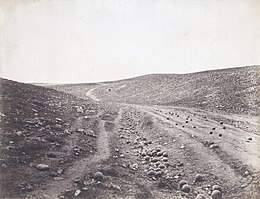This is an old revision of this page, as edited by Mistico Dois (talk | contribs) at 18:45, 23 December 2022 (New category.). The present address (URL) is a permanent link to this revision, which may differ significantly from the current revision.
Revision as of 18:45, 23 December 2022 by Mistico Dois (talk | contribs) (New category.)(diff) ← Previous revision | Latest revision (diff) | Newer revision → (diff) 1855 photograph by Roger Fenton44°34′59″N 33°32′24″E / 44.583°N 33.54°E / 44.583; 33.54


Valley of the Shadow of Death is a photograph by Roger Fenton, taken on April 23, 1855, during the Crimean War. It is one of the most well-known images of war.
Roger Fenton was sent by Thomas Agnew of Agnew & Sons to record the Crimean War, where the United Kingdom, the Second French Empire, the Kingdom of Sardinia, and the Ottoman Empire were fighting a war against the Russian Empire. The place of the picture was named by British soldiers The Valley of Death for being under constant shelling there. When in September 1855 Thomas Agnew put the picture on show, as one of a series of eleven collectively titled Panorama of the Plateau of Sebastopol in Eleven Parts in a London exhibition, he took the troops'—and Tennyson's—epithet, expanded it as Valley of the Shadow of Death with its deliberate evocation of Psalm 23.
Film-maker Errol Morris went to Sevastopol in 2007 to identify the site of this "first iconic photograph of war". He was investigating a second version of the photograph without cannonballs on the road and the question as to the authenticity of the picture. Hitherto opinions differed concerning which one was taken first, but Morris spotted evidence that the photo without the cannonballs was taken first. He remains uncertain about why balls were moved onto the road in the second picture—perhaps, he notes, Fenton deliberately placed them there to enhance the image. However, according to the Orsay Museum, "this is unlikely as the fighting raging around him would probably not have allowed him to do so". The alternative is that soldiers were gathering up cannonballs for reuse and they threw down balls higher up the hill onto the road and ditch for collection later.
References
- ^ "Valley of the Shadow of Death (Getty Museum)". The J. Paul Getty in Los Angeles. Retrieved 21 March 2021.
- Morris, Errol (4 October 2007). "Which Came First? (Part Two)". Opinionator. Retrieved 23 February 2021.
- Morris, Errol (2011). "Chapter 1". Believing Is Seeing: Observations on the Mysteries of Photography. Penguin Press. p. 310. ISBN 9781594203015.
- Morris, Errol (5 October 2012). "In the Valley of the Shadow of Doubt". RadioLab. WNYC Radio. Retrieved 8 November 2012.
This episode, which was originally podcast on 24 September 2012, was amended on 5 October 2012.
- Dicker, Ron (1 October 2012). "'Valley Of The Shadow Of Death,' Famous Early War Photo, A Staged Fake, Investigator Says (PHOTOS)". Huff Post World 10/01/2012. Huffington Post. Retrieved 8 November 2012.
- "Truth Warriors". RadioLab. WNYC Radio. 3 August 2017. Retrieved 28 September 2017.
- "Musée d'Orsay: Roger Fenton The Valley of the Shadow of Death". www.musee-orsay.fr. Archived from the original on 8 December 2008.